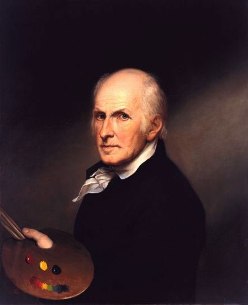
This enormous contrivance is seen being operated as a treadmill by two men like hamsters in a wheel. In use in Europe from the Middle Ages, such windlasses, moved by the force of one or a few workers and driving a bucket-chain, had been imported from China to Europe and became a common sight from the 14th Century to the mid 19th. As a sign of its importance, the windlass occupies the centre of the composition. The presence of children gives the scene a playful character, while the colour palette, based on shaded tones of yellow and brown, lend the scene an air of mystery and obscurity as the remains of the prehistoric animal (not yet revealed) are awaited, expectantly.
The eventual extraction of this skeleton took on a significance surpassing the purely scientific. In 1749, the French naturalist Georges Buffon had asserted in his Natural History that the European extinct species had been bulkier and more developed than those of the United States. So, confirming the past presence of mammoth-like creatures on American soil had become almost a patriotic duty - asserting the fact that the New World was at least the equal of the Old, right down to its prehistoric bones.
Proud of the interest created by his enterprise, Peale invites witnesses to marvel at this sight of a young science serving a young nation. The artist even borrows the pose of the Belvedere Apollo, one of the most admired sculptures of antiquity; and with this reference to the Greek god of light and the knowledge, identifies himself as an Enlightenment man, a man of science, casting light on the distant past.
According to palaeontologist John Ostrom (1928-2005), Peale’s dig was the first organised excavation ever conducted in search of prehistoric mammals in North America. It successfully unearthed an almost entire skeleton, which became universally known as The Great American Incognitum. Peale’s Museum eventually failed; the incognitum, which had become such a symbol of American national pride, had to be ignominiously sold to European collectors to pay off the museum’s creditors. For a hundred years the incognitum’s fate was truly unknown, until turning up in the Hessisches Landesmuseum, Darmstadt, Germany, in the 1950s. It can be seen there to this day.
Further reading
Paul Semonin explores the story of the Incognitum in his book American Monster: How the Nation’s First Prehistoric Creature Became a Symbol of National Identity (New York, 2000). You can read an article by him, Peale’s Mastodon – the skeleton in our closet, at www.historycooperative.org/journals/cp/vol-04/no-02/semonin/index.html. See also Semonin’s website www.americanmonster.net.
*Dr Alexis Drahos is an art historian with a special interest in Earth science’s influence on 19th Century painting. He lives in Paris.